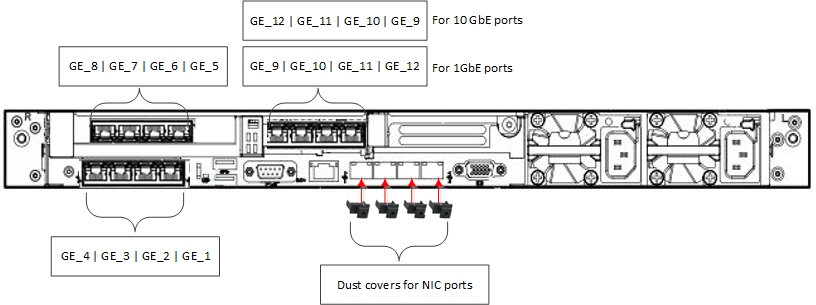Connecting Device to IP Network for 1-GbE Copper
This section shows how to connect the device to the IP network using the copper 1-GbE ports.
Intra-building connections of the device require the use of shielded cables grounded at both ends.
The intra-building ports of the equipment are suitable for connection to intra-building or unexposed wiring or cabling only. The intra-building ports of the equipment must not be metallically connected to interfaces that connect to the Outside Plant (OSP) or its wiring. These interfaces are designed for use as intra-building interfaces only (Type 2 or Type 4 ports, as described in GR-1089–CORE, Issue 4) and requires isolation from the exposed OSP cabling. The addition of primary protectors is not sufficient protection to connect these interfaces metallically to OSP wiring
The device's management interface uses special string names to represent the Ethernet ports, as shown in the following figure:
Management Name per Physical Ethernet Port – Mediant 9080 / Mediant 9000 Rev. B

Management Name per Physical Ethernet Port – Mediant 9030

| ● | Mediant 9080 / Mediant 9000 Rev. B: The figure represents a configuration with 12x1GbE ports. If the device is configured with 10GbE ports (GE_9 until GE_12), then the correct port order is as follows: GE_12 | GE_11 | GE_10 | GE_9. |
| ● | Mediant 9030: GE_1, GE_2, GE_3, and GE_4 ports can be used only for signaling (SIP), OAMP, and HA Maintenance. These ports must not be used for media traffic. |
| ➢ | To connect the device to the IP network: |
| ■ | Use an Ethernet cable to connect an RJ-45 network port on the server's rear panel to the LAN. |
Connecting the Device to the IP Network - Mediant 9080 / Mediant 9000 Rev. B

Connecting the Device to the IP Network - Mediant 9030

| ● | The port used for OAM&P depends on the Mediant 9000 series product: |
| ✔ | Mediant 9080 / Mediant 9000 Rev. B: Port GE_1 |
| ✔ | Mediant 9030: Port GE_5 |
| ● | The HP iLO port is not used for management of the SBC application; it's used only for hardware management and monitoring. For more information, refer to HPE's documentation. |